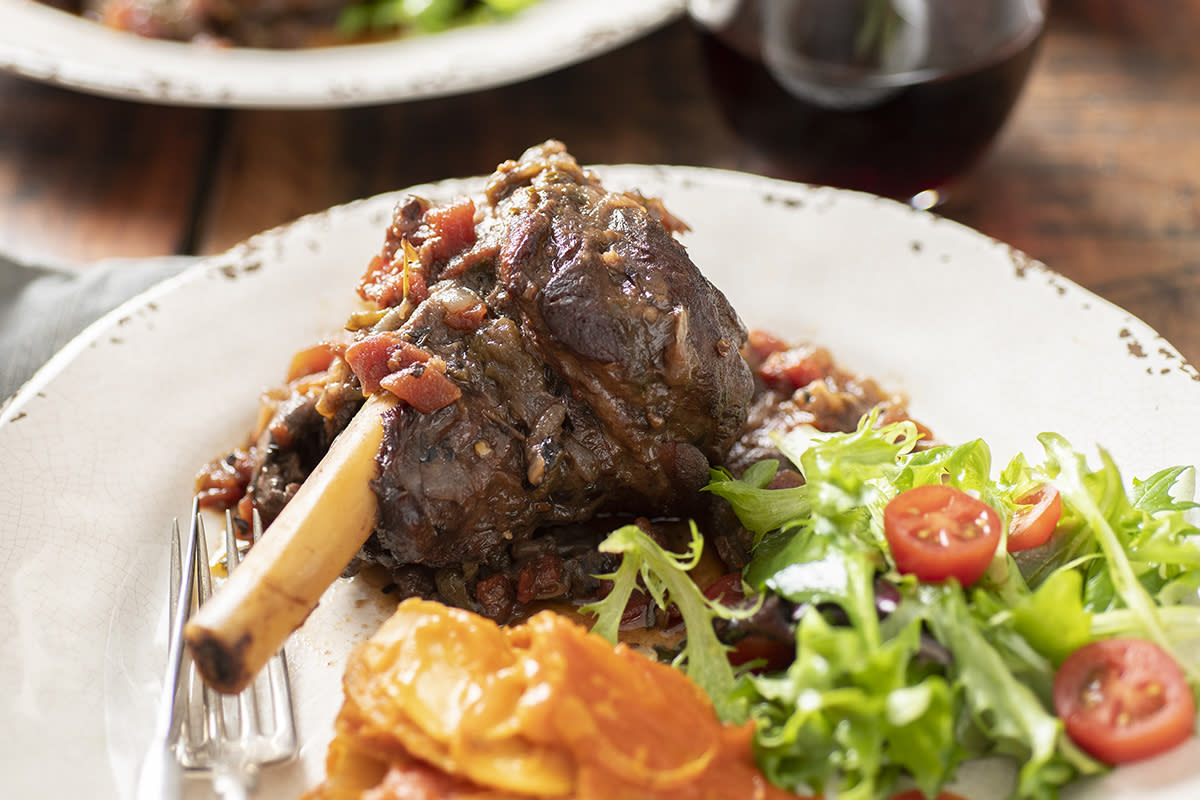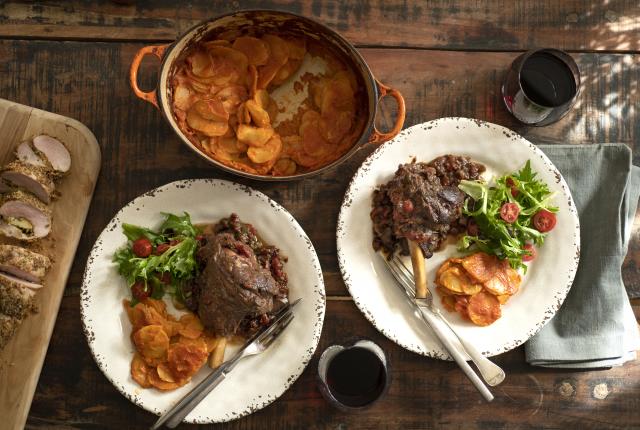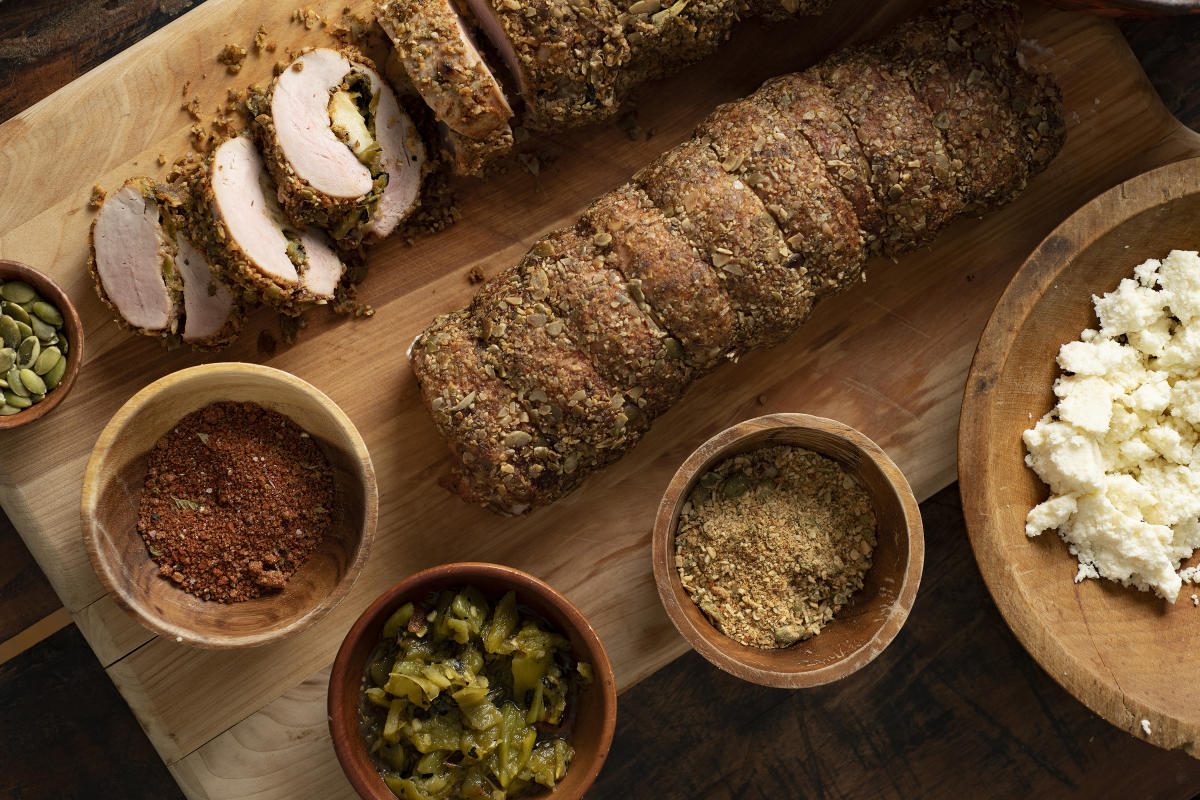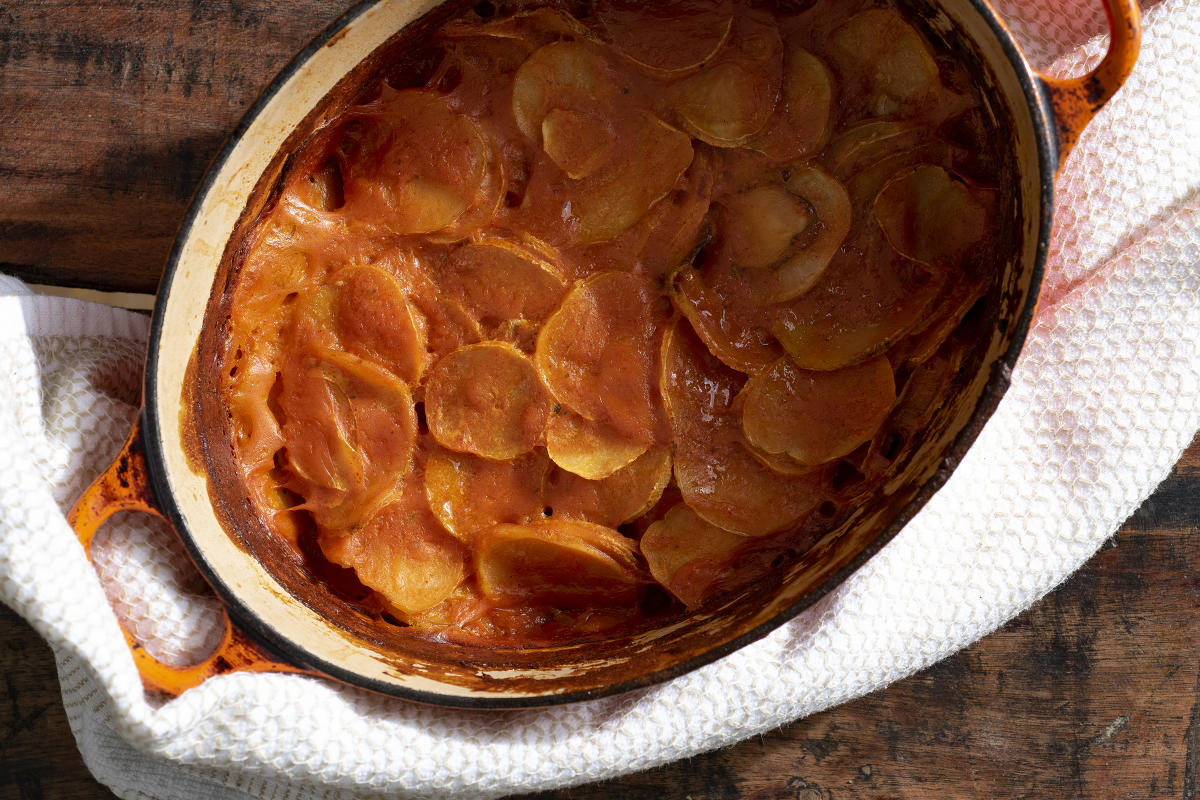MY YOUTH IN UPDATE NEW YORK included meals made by a mom who was not an adventurous cook, so “exotic” meats were rarely served. If lamb made it to the table, it was a platter of well-done and reasonably priced shoulder chops that required a good dousing of mint jelly. When Easter rolled around, we had ham, studded with the ubiquitous whole cloves and canned pineapple slices placed snugly with toothpicks. My grandfather was a Methodist minister, so the emphasis, I suppose, was more on the resurrection than on the repast.
We always had simple scalloped potatoes that, oddly, were made with milk instead of cream, which I guess helped keep me pious and away from the sin of gluttony. I do remember a few years when a fancy Easter egg–shaped ice cream cake, stuffed with jelly beans and covered with green coconut, appeared. That was special. And of course, the great thing about ham is that there were always leftovers for sandwiches.
Wondering what other families had—the great ham-or-lamb holiday debate—I posted the question on social media and received a healthy response from more than 100 fellow foodies. Ham reigned as king, with 55 votes, while lamb, both legs and chops, weighed in at 38. Folks who celebrated Passover preferred brisket, and everyone liked deviled eggs and scalloped potatoes, to round out the menu. A few surprising options? Turkey noodle casserole, green chile kugel, barbecue, pheasant, and rabbit (that one’s a bit macabre around Easter Bunny time, right?).
New Mexico has both lamb and pork ranchers who offer multiple local options one can consider instead of store-bought varieties. The ones I’ve encountered promote sustainability and humane practices along with other positive buzzwords, such as “product traceability” and “transparency in the marketing.” A quick search for a state-originated ham producer turned up nil, although one pork provider did offer to cure a pig for me should I be able to supply one. (I couldn’t.) A smaller provider required preordering in the fall. Other pork cuts, though, are available.
Historically, the reasons why lamb and ham are popular during this time of year vary. In a religious sense, lamb has always been considered an Easter and Passover dish. For Christians, Jesus is the “lamb of God,” and the dish is considered a tribute to or remembrance of his sacrifice. Among Jewish people, the connection comes from lamb blood that was smeared over doorways by the Israelites to save them from destruction.
But there’s an agricultural sense to these holiday meats as well. Lambs are born in the spring. Ham was traditionally made from pigs fattened with apples and acorns in the fall. Before refrigeration, the meat needed to cure during colder months and was ready to eat by spring.
Whichever holiday you celebrate, and whatever meat graces your family table, give it some New Mexico flavor this year.
 Green Chile Lamb Osso Buco
Green Chile Lamb Osso Buco
I think osso buco—Italian for “bone with a hole”—made with lamb shanks is so much tastier than the traditional version, made with veal shanks. You may find shanks that are crosscut as in the traditional veal version (ask your butcher), but whole shanks work, too. Check the meat after two hours; you don’t want the lamb to fall completely off the bone but to pull away easily. Serve with a potato side dish or wild mushroom risotto. Osso buco is great for entertaining. You can cook it completely, then rewarm when you’re ready to serve.
4 lamb shanks, approximately 10 ounces each
2 teaspoons kosher salt, divided
2 teaspoons freshly ground black pepper, divided
½ cup flour
4 tablespoons olive oil
4 garlic cloves, minced
1 large yellow onion, diced
1 cup mushrooms, quartered
2 tablespoons fresh thyme leaves
14.5-ounce can diced tomatoes, with their liquid
4 cups chicken stock
1 cup dry red wine like merlot or cabernet
1–2 bay leaves
1 cup New Mexico green chile (mild or hot), roasted, peeled, seeded, and chopped
Sprigs of parsley
Serves 4
INSTRUCTIONS
- Mix together 1 teaspoon salt and 1 teaspoon pepper with the flour, and dust the shanks on all sides. Place olive oil in heavy-bottomed Dutch oven or roasting pan and brown shanks on all sides over medium heat. Remove shanks from Dutch oven or pan and set aside.
- Turn heat up to medium high and add garlic, onions, and mushrooms to Dutch oven or pan. Sauté until onions start to brown.
- Add thyme, tomatoes, stock, and wine to Dutch oven or pan. Allow liquid to come to a boil. Stir in remaining salt and pepper and bay leaves and green chile. Nestle the shanks into the sauce; they may not be completely covered with liquid, but that’s fine.
- Cover Dutch oven or pan, place in preheated 400° oven, and cook for approximately 2½ hours. The dish is done when shanks are very tender and almost falling off the bone. Serve in a bowl with “gravy” ladled over it, topped with parsley.
This tasty green chile–stuffed pork loin has a crunchy crust that helps keep the meat moist while roasting. Consider serving it with a simple sauce made by combining equal parts sour cream and salsa verde (Herdez is a popular brand). You can find queso fresco in most grocery stores near the cream cheese. Pepitas are often sold in bulk; I prefer the salted version. (Still determined to roast a ham? Start with spiral-cut. For a zippy norteño glaze, add ground New Mexico red chile to maple syrup or honey, or combine orange marmalade with canned chipotles.)
PORK
2 pork tenderloins, 1¼ pounds each
¾ cup New Mexico green chile (mild or hot), roasted, peeled, seeded, and chopped
4 ounces queso fresco
1 cup pepitas (shelled pumpkin seeds), toasted
2 egg whites, beaten until frothy
SANTA FE RUB
2 tablespoons brown sugar
1½ teaspoons mild New Mexico red chile, ground
1½ teaspoons hot New Mexico red chile, ground
¼ teaspoon black pepper
½ teaspoon kosher salt
½ teaspoon garlic salt
1 teaspoon Mexican oregano
1 teaspoon cumin seed, toasted and ground
Serves 6–8
INSTRUCTIONS
- Preheat oven to 375°. In a small bowl, mix the ingredients for the dry rub; set aside.
- Slice the queso fresco into 4-by-¼-inch logs; set aside.
- To butterfly the pork tenderloins, trim off any excess fat or silver skin on the outside. Using a sharp knife, slice down the middle of each loin, lengthwise. Go slowly and steadily. Don’t slice completely through the meat.
- Lay the pork on your cutting board, cover it with a piece of plastic wrap, and flatten the tenderloin using the smooth side of a mallet or tenderizer to an even ¼-inch thickness by approximately 5 inches across.
- Lightly season each pork surface with 1 teaspoon of the dry rub. Working lengthwise, place the chopped green chiles on the pork, slightly off the center. Set the queso fresco next to the chiles in the same direction.
- Roll the pork into a long log carefully over the filling, tucking in anything that falls out. Secure the roll as needed with 4–5 loops of butcher’s twine. Season each log with 1 teaspoon of the rub.
- Whirl the pepitas in a food processor or blender until they resemble coarse bread crumbs. Stir in 2 teaspoons of dry rub and place on a cookie sheet. Brush the meat with the egg whites and roll over the pepitas mixture, pressing to adhere.
- Place the pork in a sided baking dish and roast for 35–40 minutes, until the pork has at least a 145° internal temperature. Remove from the oven. Let rest about 10 minutes before slicing. Reserve leftover rub for another use.
These rich and creamy scalloped potatoes are a perfect side dish for your favorite lamb, pork, or other protein. Using a mandoline to slice the potatoes works well. For my vegetarian friends, I grill a thick slab of olive-oiled and well-seasoned eggplant and serve that as a “steak” to accompany this dish.
3 medium potatoes (or sweet potatoes), washed, peeled, and sliced ⅛ inch thin
4 egg yolks, lightly beaten
1 cup heavy cream
2 cups milk
1 cup sour cream
1 cup shredded sharp cheddar cheese
¼ cup mild New Mexico red chile, ground
1 teaspoon hot New Mexico red chile, ground
1 teaspoon cumin, toasted and ground
1½ teaspoon salt
Butter for casserole
Black peppercorns
Serves 6–8
INSTRUCTIONS
- Preheat oven to 400°. Spread potato slices on paper towels and blot dry. (If you live above 4,000 feet elevation, blanch the sliced potatoes in salted boiling water for 5 minutes. Drain and blot on paper towels.)
- In a medium bowl, whisk together yolks, cream, milk, sour cream, cheese, mild and hot red chiles, cumin, and salt.
- Butter a 4- to 5-quart casserole dish. Alternate 4 layers of potatoes and ladles of the milk mixture. Crack black pepper over potatoes.
- Cover with the casserole lid or foil and bake for 30 minutes. Uncover and continue baking until casserole is bubbling and nicely browned, about 20 minutes. Test for doneness by inserting the tip of a sharp knife into the center of the dish, making sure potatoes are tender.
Where’s the Meat?
How to put locally grown lamb and pork on your holiday table.
This is a partial list of New Mexico meat suppliers. Many of their products are sold in stores, and some of the ranchers ship, too. It’s best to contact them directly and establish a relationship in case you need to preorder for next year’s production. All the ranchers I spoke with were more than happy to talk about their growing and processing methods.
High Country Meats, Ratón. Pork and beef. 575-445-2449
Night Sky Lamb, Melrose. Lamb, including skilpadjies, a South African meatball. 575-749-7626
Dunhill Ranch, Magdalena. Lamb and beef. 575-854-2847
Shepherd’s Lamb, Tierra Amarilla. Lamb, pelts, wool, blankets. 505-795-3671
Talus Wind Ranch, Galisteo. 505-982-7782
Read More: This fresh, locally grown lamb and pork tastes great—and does good deeds.




